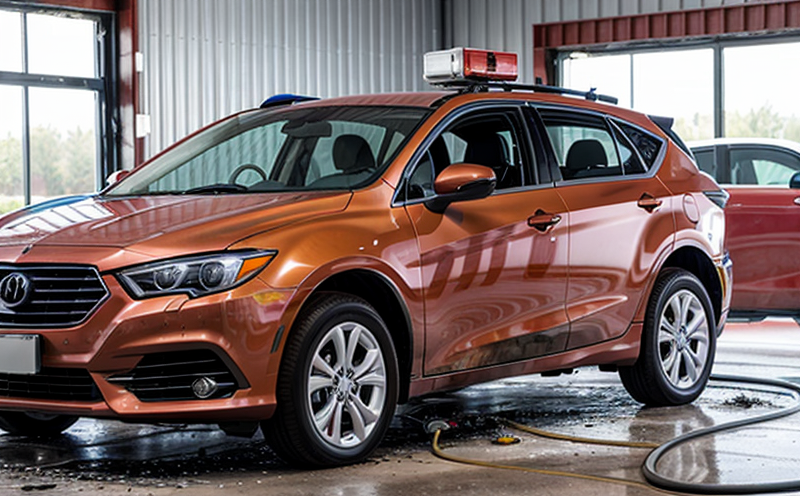Fire Safety Testing of Console and Trim Components
In today’s automotive industry, fire safety is a paramount concern. The console and trim components within vehicles are often made from various materials such as plastics, foams, and textiles. These materials can contribute to the spread of flames or may emit toxic fumes under certain conditions. Ensuring these components meet stringent fire safety standards is crucial for protecting passengers in case of vehicle fires.
The primary objective of fire safety testing for console and trim components is to evaluate their resistance to ignition and flame propagation, as well as their ability to suppress flames if they do ignite. This testing aligns with international standards such as ISO 56601:2014 and ASTM E84-19, which provide guidelines for assessing the smoke-producing characteristics and flame spread performance of materials used in automotive interiors.
Testing is conducted using specific apparatus designed to simulate real-world conditions. For instance, specimens are exposed to sources of ignition such as cigarettes or open flames. The time it takes for the fire to reach a certain point along the specimen, and how quickly it extinguishes, are critical parameters that determine compliance with safety regulations.
Specimen preparation is meticulously followed to ensure accurate testing results. Trim pieces like door panels and console inserts are cut into standard sizes and shapes to facilitate consistent testing across all samples. The materials used in these components undergo thorough inspection for defects or inconsistencies before testing begins.
The test apparatus includes a vertical tunnel furnace, which allows for the controlled exposure of specimens to flames while measuring relevant parameters such as smoke density and heat release rate. This setup ensures that the tests are conducted under standardized conditions, making them reliable indicators of real-world performance.
Upon completion of testing, detailed reports are generated summarizing all test results. These reports typically include information about flame spread ratings (FSR), smoke density levels, and other key metrics derived from the experiment. Compliance with relevant standards is clearly indicated in these reports, providing quality managers and R&D engineers with valuable insights into product performance.
Understanding the importance of fire safety testing goes beyond compliance; it enhances passenger safety significantly. By ensuring that all parts of the vehicle interior meet rigorous safety criteria, manufacturers can reduce the risk of injury or death caused by fires. Moreover, adherence to these tests helps maintain brand reputation and consumer trust in automotive products.
In summary, fire safety testing is an indispensable part of modern automotive manufacturing processes. It plays a vital role in safeguarding passengers against potential hazards while also contributing to overall product quality assurance. Through precise measurement techniques and adherence to recognized standards like ISO 56601:2014 and ASTM E84-19, companies can confidently produce safer vehicles that meet both regulatory requirements and customer expectations.
Why It Matters
The importance of fire safety testing cannot be overstated when it comes to automotive components like console and trim parts. These elements are not only exposed directly to passengers but also interact with other materials inside the vehicle, potentially affecting overall fire risk.
One critical aspect is preventing fires from spreading rapidly within confined spaces such as vehicles. The console and trim pieces act as pathways for flames to travel quickly if a fire starts somewhere else in the cabin. By ensuring these components do not exacerbate the situation, manufacturers can significantly enhance occupant safety during emergencies.
Another significant concern is minimizing smoke production from materials used in consoles and trims. During a fire, the release of toxic gases can pose serious health risks to passengers. Testing helps identify which materials are safest by quantifying harmful emissions, allowing for informed decisions about material selection and design improvements.
From an economic perspective, rigorous testing ensures that vehicles comply with applicable regulations. Non-compliance could lead to costly penalties or recalls post-launch. Early identification of issues through testing saves time and resources in the long run, promoting efficient product development cycles.
Moreover, consumer perception plays a crucial role here too. A reputation for producing safe products builds brand loyalty among customers who value their well-being above all else. Demonstrating commitment to fire safety standards instills confidence in potential buyers, thereby boosting sales and market share.
The automotive industry has seen numerous advancements in technology aimed at improving interior design while maintaining high levels of fire protection. Testing these innovations ensures they function as intended under extreme conditions without compromising on quality or performance. Thus, it becomes essential for both new entrants and established players alike to incorporate robust testing practices into their workflows.
In conclusion, fire safety testing is indispensable in safeguarding passenger lives and upholding industry standards. Its significance extends beyond mere compliance; it sets the stage for creating safer vehicles that meet stringent regulatory requirements while enhancing overall consumer satisfaction.
Industry Applications
The application of fire safety testing in automotive manufacturing is widespread, covering various aspects from initial design stages to final production processes. During early development phases, engineers rely on simulation tools and mock-ups to predict how different materials might behave under fire conditions before committing significant resources towards actual prototypes.
Once prototype designs are finalized, full-scale testing follows using real-world scenarios where consoles and trims are subjected to controlled ignition sources in specialized laboratories. This step ensures that all elements work harmoniously together without contributing to increased fire hazards or toxic emissions.
In parallel with manufacturing, quality assurance teams continue conducting periodic checks throughout assembly lines to verify ongoing compliance with established standards. These inspections help catch any deviations early on, enabling quick corrective actions if necessary.
For售后服务保障,请关注以下几点: 1. 确认保修范围和期限:了解所有维修、更换零件和服务的详细条款。 2. 选择正规渠道购买配件或服务:以避免使用假冒伪劣产品,确保服务质量。 3. 定期维护保养:按照制造商建议的时间表进行检查和维护,有助于延长车辆使用寿命并提高性能。





